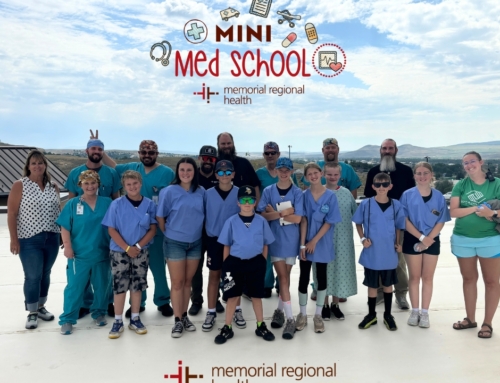What you should know about the shingles vaccination series
Almost 1 in 3 people will get the painful rash at some point in their lifetime, but there is an effective preventative vaccine available
Want more local healthcare news sent straight to your inbox? Sign up for our virtual Living Well newsletter here.
Did you ever have chickenpox as a kid? The same virus is responsible for shingles, an uncomfortable and painful rash that mostly affects older adults over the age of 50 and the immunocompromised.
According to the Centers for Disease Control and Prevention, about one in every three adults will develop shingles at some point in their lifetime. The National Foundation for Infectious Diseases reports there are about 1 million annual cases of shingles in the U.S. The virus is basically a reactivation of chickenpox, and it is still unknown in the medical community as to why the viral infection reactivates after several years.
Having shingles isn’t something you want to get — it’s itchy, painful and can bring on a burning sensation or numbness. Luckily, there is an established vaccination series that can help reduce your risk so that you don’t have to worry about dealing with the same itchy, irritating mess you did when you were a kid.
What are shingles?
Shingles are a type of rash caused by varicella zoster — the same virus found in chickenpox. Since the virus doesn’t completely dissipate for those who had chickenpox as a child, it’s possible for it to come back again in a different form when you’re older. It hides dormant in your body and can reemerge as shingles in your adult years.
The rash most typically presents itself as a stripe of blisters on the side of the torso, according to the Mayo Clinic, and signs and symptoms people experience include:
- Pain, burning, numbness or tingling
- Skin sensitivity
- A red rash that forms a few days after the virus emerges
- Itching
- Blisters filled with fluid that break open and crust over
- Flu-like symptoms such as fever, headache, fatigue and chills
- Sensitivity to light
It’s important to note that some people experience shingles pain without ever developing the rash itself. The rash is contagious and can be passed along to anyone without immunity to chickenpox, specifically through direct contact with the open sores of the rash.
Other common areas for the rash to develop include around one eye or on the side of the neck and face area. Individuals should immediately visit with their healthcare provider if any of these symptoms present.
Get your shingles vaccine series
Both doses of the shingles vaccine are available at any MRH Community Pharmacy location. The doses are recommended for adults 50 years and older and are taken between two to six months apart to prevent complications from the disease. Call for more information or to learn about other immunizations offered at our pharmacies.
Craig Pharmacy:
Medical Office Building
750 Hospital Loop
970-826-3055
Learn more here
FAST FACTS: Risk of getting shingles and potential complications
- About 1 in every 3 people in the U.S. will develop shingles at some point during their life.
- People who have had chickenpox are at higher risk for shingles.
- More than 99 percent of Americans born before 1980 have had chickenpox, even if they cannot recall having it.
- Your risk of getting shingles and having serious complications from the disease increases with age.
- About every 1 in 10 people who get shingles develop nerve pain called postherpetic neuralgia that can last for months — even years — after the rash disappears.
- Postherpetic neuralgia is the most common complication of shingles, but other serious complications that can result from the disease include blindness, pneumonia, hearing problems, brain inflammation — also known as encephalitis — or death.
Source: Centers for Disease Control and Prevention
About the vaccine
Currently, the U.S. Food and Drug Administration has two vaccines that are approved to prevent shingles: Zostavax and Shingrix. These vaccinations are the only way to protect against shingles and complications from the virus, according to the CDC.
Zostavax is a live vaccine, meaning it contains a weakened form of the virus that enables your body to become familiar with and build the strength to fight against it when it is exposed to the real virus. Shingrix is a recombinant vaccine, which means it includes altered DNA in order to produce an immune response to fight the virus. Shingrix is the recommended vaccine that the CDC suggests whenever possible, since it is more effective and lasts longer than the Zostavax vaccine in fighting shingles.
The Shingrix vaccine is given in two doses about two to six months apart, and it has as high as a 90 percent efficacy rate in preventing shingles and related nerve pain. Zostavax has about a 51 percent success rate. Individuals who’ve had shingles should still get the vaccine.
Cost and fear of injections are common reasons individuals choose not to get vaccinated for the disease, but healthcare experts urge people to get the vaccine if they are able to. To learn more about how much the vaccine may cost you, contact your health insurance company.
Who needs the vaccine?
According to the National Center for Biotechnology Information, your chance of getting shingles a second time is about the same as the first time — which is why the vaccine is so important to get in order to prevent the virus in the first place.
The older you get, the more likely you are to develop shingles, which is why the vaccine is recommended for individuals older than 50, but definitely for those older than 60. It is recommended that anyone born before 1980 get the vaccine; however, the virus can be found in healthy younger adults and children, in some cases. Those who are immunocompromised are also at an increased risk for shingles, according to the National Foundation for Infectious Diseases.
Other people who should get the vaccine are those with a family history of shingles or who have already received the Zostavax vaccine in the past and want to receive the Shingrix vaccine. There should be a minimum eight-week waiting period between getting the Zostavax vaccine and the Shingrix vaccine.
As always, if you are unsure if you should receive the vaccine or if you’re a candidate to receive the vaccine, contact your primary care provider for more information. Memorial Regional Health offers the vaccine in our Community Pharmacy locations for those who do wish to receive the vaccine.






